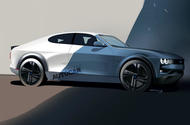Autocar first reported potential for electric Capri in 2019
Amid reports Capri is coming back, Ford design boss tells Autocar “the public loves” old nameplates
Ford is poised to resurrect the hallowed Capri nameplate for its second electric crossover on VW’s MEB platform, according to a report in The Sun.
Following the unveiling of the new Ford Explorer SUV yesterday, it has emerged that car’s twin – due to be revealed early next year – is tipped to take its name from the two-door sports coupé Ford sold in huge numbers across Europe from 1968 to 1986.
Autocar first reported in 2019 that the Capri name was in the frame for a revival, and now – in an exclusive interview with the firm’s chief European designer Amko Leenarts – has heard just how important historic nameplates will be for Ford as it progresses with its electric revolution.
Talking to Autocar ahead of the Explorer reveal, Leenarts spoke excitedly and passionately about the next stage in the company’s evolution as he showed us around his slick, expansive Merkenich Design Studio, just down the road from the company’s Cologne factory.
He joined Ford 11 years ago (when its range was several times larger than it will be by 2025) and is now charged with leading the brand into its bold new electric future, starting with the Explorer.

Importantly, he said, Ford’s redeploying of historic names does not herald the advent of nostalgic styling cues: “Retro designs aren’t moving us forward. It’s always about totally new interpretation: that’s what makes it interesting.”
What happened when we had a go at resurrecting the legend? Back by popular demand: reinventing the Ford Capri
The Explorer, for example, is an entirely different proposition from its much larger US-market namesake but, highlighted Leenarts, has been designed with the same focus on active customers and functionality. “It’s not a surprise that that is the first car in our Adventurous Spirit range,” he said.
He did not offer any hints as to which other Ford names are up for revival, nor did he indicate what qualifies an old badge for a comeback, but he revels in “the tension between something that’s got the equity of an older name and the new interpretation”.
It’s a topic that will have been debated hotly in Ford’s customer focus groups over the past few years, since the firm reused the names Puma for a crossover and Mustang for an electric family SUV.
Ultimately, thinks Leenarts, “the public loves that we’re bringing nameplates to new territories”, because they tap into a “unique perspective that nobody else has”.
While the names may be familiar, though, the designs really won’t be. As the first of a new breed of Fords conceived under the Adventurous Spirit banner, the Explorer sets the tone for every bespoke EV that will follow it over the coming years. Direct references to previous Ford models are few and far between, both inside and out.
Likewise, the new-generation Capri will (as hinted in preview images) be a higher-riding proposition, and will gain a pair of extra doors in line with its family crossover billing. Specifications will no doubt be broadly identical to the Explorer, which offers up to 335bhp and a maximum range of more than 300 miles.
Leenarts explained that the onset of electrification provided an opportunity to cater to evolving customer requirements with what’s arguably the biggest shift in Ford design since the New Edge ethos of the late 1990s: “We started researching first: how do customers look at us? I felt personally that we were looking too positively on our own brand; we needed a health check on where we really were. And that’s whywe did work with the customers.
“What was really hurting me was them saying we were boring. And that was the part I got really engaged in. I said: ‘Okay, we have to come up with unique proposals: car designs that are clearly differentiated, that offer a unique perspective that nobody else has.’”
That the Explorer looks nothing like the Puma or Kuga, for example, is testament to Ford’s commitment to conveying its new American-flavoured image and serves as proof for the enhanced freedom afforded to car designers by flat-floored, engineless EV architectures.
“Electric car [design] language for us automatically came with simplification: cleaning it up, making sure that we get not only the bold proportions and stance, the language much more simplistic, but with that it almost feels more expensive, more premium, more approachable as well. So we’re not doing aggressive cars here. We’re actually doing cars that you can love easily,” summarises Leenarts.
“I want to make a product that’s exciting. I want to make a product that you really love. And in order to do that, it needs to have a beautiful sculpture; it has to have a couple of details that really stand out but are, again, easy to love.”
Asked whether there are any pitfalls of EV design that he tries to avoid, he says: “I think there are some products out there that try a little bit too hard, and in the end it gets to something that’s almost an appliance design. So a pitfall is appliance design. Don’t make it look like an appliance; it’s got to be sexy.”
Source: Autocar
